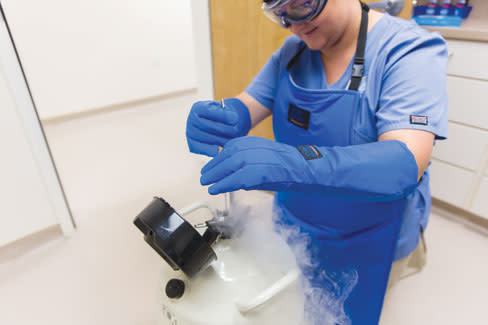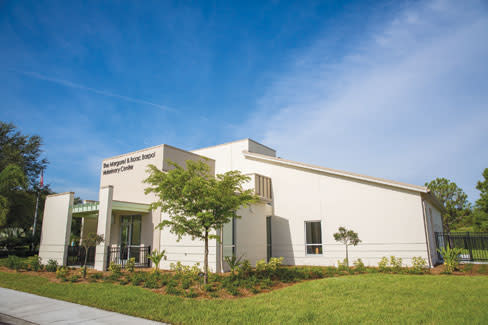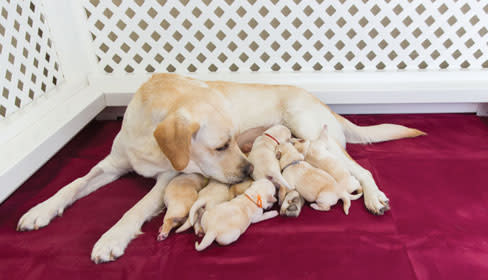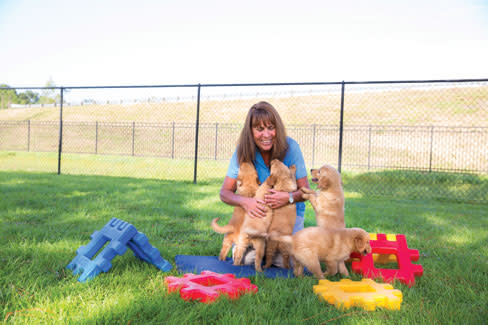Southeastern Guide Dogs: A New Breed of Superhero

I am sitting uncomfortably in an un-air-conditioned building on a remote, 35-acre campus in Palmetto in a circle of 20 other people. We all have an eager, portentous look—we could be here for a yoga retreat or a cult’s bonding exercise or maybe a round of mixed-age hokey pokey, but we are not. We’re here for something rarer and much more thrilling. The motley crew—elderly people, parents, high schoolers, one bemused writer and kids galore—are all unified in adrenalized excitement. To express it in the emotional mathematics of the many goggle-eyed children in the room, the giddy anticipatory vibe is like Christmas morning times Disney World times every birthday we’ve ever had, and then, just when it seems like no one can stand it for one more second, a door flies opens and the madcap, bumbling, downy-soft puppies rush in.
What ensues is an absolute bacchanal of face licking, tail wagging, lap bounding, and all-around gamboling and merriment. The puppies—only six weeks old—frolic with each other, nibble on fingers, attack shoelaces, pee exultantly in unexpected places, and get cuddled, embraced, tickled, nuzzled, babytalked, and adored. A yellow Lab slathers a little blond girl into uncontrollable giggles. A black Lab, biting down on a length of braided rope, plays tug of war with a little boy. Three other puppies get a running start and stampede across the room until they slide splay-legged into my lap. And in the corner one independent-minded fellow gnaws on the plastic sheeting around one of the bench’s legs that has already been chewed so often, and so ardently, that it is almost completely degloved.
This jamboree isn’t a promotion by a pet shop or a breeder. These dogs aren’t for sale. They aren’t vamping for adoption. And although you can take one home with you for a weekend—more on that soon—none of these dogs will ever be owned by anyone in this room, for these are not normal puppies.
These young Labs and golden retrievers and mixes are genetically elite; they are elect; they are fated for greatness. They have been bred in a state-of-the-artcanine laboratory to be the healthiest, most intelligent, most loyal, most patient, most super-heroic dogs anywhere in this country.
After two years of highly specialized training, they will become graduates of Southeastern Guide Dogs, and they will spend every day until their retirement helping people—from the visually impaired to veterans to the elderly or injured or depressed—with the most important of all tasks: recovering their lives.


Southeastern Guide Dogs is the brainchild of Dr. Harris Silverman and Robert Miller, who co-founded the nonprofit in 1982. Since then the organization has matched more than 2,800 dogs with visually impaired handlers, bringing them freedom, mobility and dignity they could otherwise never have known. And starting in 2006, its Paws for Patriots initiative has placed service dogs with veterans with visual impairments or PTSD and brought dogs to help veterans in military bases and hospitals such as Walter Reed, Quantico and Camp Lejeune.
It’s impossible to calculate the number of lives that Southeastern has improved or even saved, but here are some factoids that illustrate the scope of their philanthropic efforts: Each one of these dogs costs roughly $60,000 to produce; their training is a sophisticated two-year process that requires the exertions of trainers, scientists, medical staff, caretakers and volunteers; applicants to become handlers, who come from all 48 contiguous states, are thoroughly screened by admissions officers, and those who are approved are assisted by a matchmaking service that includes individual in-house visits to determine what kind of dog would best fit their lifestyle, temperament, and physical needs; these student handlers then come to the campus in Palmetto for a 26-day training course with the dog who has been specifically matched to them; and if a graduate handler has a problem of any kind with a guide dog, someone from Southeastern will fly out to their home and help both dog and handler work through it.
The cost to the dog’s handler for all of this care and training? A mind-boggling zero dollars.
Happily, with nearly $25 million in total assets, Southeastern Guide Dogs can afford it. But astonishingly, that money has been accrued not by any kind of grant-writing or governmental aid but entirely by donations. The secret to their fund raising, Silverman says, is that people like to donate to programs that are financially solid and that accomplish real and tangible success.
“Well, that,” he says, “and this.”
Then he holds up a brochure with a picture of a beatific golden retriever puppy.
And Silverman is not kidding. These dogs are so irresistible that sometimes just an image of one is sufficient to pry funds loose from donors who weren’t even thinking about donating. A few years ago, for example, Isaac Barpal, an engineer who developed one of the first hybrid electric vehicles and was instrumental in the creation of San Francisco’s BART transit system, was riding his motorcycle down the highway when he saw a puppy on a billboard promoting Southeastern. Charmed and curious, he pulled off the road, checked out the campus, and, suitably impressed, he offered—bang, just like that, with the why-not caprice of a man making a detour to pick up a gallon of milk at the store—to pay via matching funds for a state-of-the-art veterinary center.
Opened in 2013, the $1.75 million Margaret and Isaac Barpal Veterinary Center is a 6,000-square-foot medical Xanadu chock-full of cutting-edge technology. There is an examination room with tables on hydraulic lifts, an ophthalmology lab, a genetics and reproduction procedures room complete with cryogenic storage preserving literally millions of dollars’ worth of doggie DNA, male and female breeder wards, a treatment/recovery/ICU center, a quarantine room with a special ventilation system to provide negative air pressure so no contaminants or germs can escape, a surgical center with positive air pressure for the opposite reason, and a canine lounge that functions as a love motel for dogs who are slated to procreate au naturel. This particular room is kept “dirty”—uncleaned—for three days after copulations so as to create the aphrodisiacal funk that encourages dogs to mate—but otherwise the whole place is characterized by gleaming Apple computers, pouty elegant orchids, leather couches and glossy polished surfaces, producing a feeling much less like a veterinary center than a concierge-grade medi-spa.
The rest of the campus gives a divided impression, however. Some of the buildings, like the student dorms and the puppy center and the CEO’s office, which is in the former kitchen of a house, are aging and in need of refurbishment or replacing; others, like the Keith G. Hirst Canine Assessment Center, are brand-new and purpose-built. But wherever you go the attitude is one of focus and discipline and activity.
Staff in sporty blue polo shirts stride purposefully about, volunteers avidly walk dogs on martingale leashes, tour groups go by in delighted flurries, and everywhere you look are dogs. Quite a few of the 110 employees bring their own pets to work, and if you combine them with Southeastern’s official wards, there can be as many as 200 dogs on campus at one time, yet somehow they are never underfoot. And strangely they produce almost no noise. You’d expect the place to be a Thunderdome of barking and howling and humping, but that is not the case. True, the dogs chorus a bit at feeding time, and in the puppy center you’ll hear some playful yipping; but if you were to gather together 200 human teenagers and 200 dogs and measure their manners with a decibel meter, these dogs would win, paws down.
How does Southeastern do it? How do they take animals renowned for behavior that includes dining upon their own feces, chewing supposedly unchewable objects and leg-humping guests at dinner parties, and turn them into such gentlemanly squires? According to CEO Titus Herman, one part of the answer is, simply, its employees and volunteers.
“We just have the best people,” he says.
He could be referring to Rachel Goldammer, a geneticist who in only six years of selective breeding has reduced the rate of hip dysplasia from an average of 50 percent to a startling, nearly miraculous 3 percent and decreased the average puppy mortality rate from 15 percent three years ago to 1.5 percent. Then there is Karen Mersereau, who assesses the dogs after they come back from their “puppy raisers” (volunteers who take the puppies into their homes to teach them basic manners and trust) to decide the kind of work for which a dog will be best suited. Or perhaps Suzy Wilburn, who lost most of her vision after she was diagnosed with Stargardt disease at age 27 and who works now alongside her Southeastern guide dog, Carson, as the head of admissions and graduate services, deciding which applicants are best suited for dog ownership. (About 40 percent of applicants are accepted.) Or perhaps Jacqui Garvey, who, being in charge of the puppies from birth until 10 weeks old, might just have—and this is not hyperbole—the best job in the entire world.
But the workers here, despite their dedication and boundless enthusiasm, are only half the story. The other part, of course, is the dogs’ remarkable training.


Over its 32 years, Southeastern’s training regimen has evolved into an exacting system that recalls in many ways the training of Spartan boys. From the highly advanced genetic science that goes into breeding every dog to the meticulous training, these animals are literally made for their jobs.
Their training begins only three days after birth.
They learn to trust the people who feed and handle them. They must accustom themselves to noises, various surfaces and environments, and distractions. They are encouraged to investigate the unknown. They are assessed for persistence (will a puppy disengage with a food-stuffed kong to engage with a human?) and patience (will it still engage with a human after being ignored for 15 seconds?) and resilience (is it unruffled by a motorized snowman that sings an annoying tune?) and social interaction (will it greet a breed of dog it has never seen before?). In their quarters and play pens they have toys dangling overhead to encourage them to see things from a human perspective—so they can be aware of low-hanging branches or other impediments that might pose a risk for their handlers—and they are routinely confronted with startling objects that they learn to understand or negotiate, such as mirrors and surfaces of different textures and teeter-totters and ledges with drop-offs. Then of course there is that “puppy hugging,” to help socialize the puppies.

After only 10 weeks, they are able to sit, go down, and walk more or less cooperatively on a leash, and they are given names—an honor available to any sponsor willing to part with $5,000. Then they are sent out to live with their puppy raisers for the next year and a half. During this time the dogs will learn the routine matters of being a dog. They become acquainted with a home, a family, other pets, yards, sidewalks, stairs, squirrels, traffic, you name it.
At about 16 months the puppy raisers must return their charges to Southeastern Guide Dogs—a tearful event that is assuaged by a celebration that acknowledges the gravity of the dog’s destiny—and then they spend their next four to six months being trained on campus. They will learn a lexicon of over 40 commands, ranging from directional signals like “forward” to things as arcane as “find my keys.” They will also have assessments to measure things like their social tolerance (will they let you fiddle with their ears or mess with their teeth?) and physical sensitivity (does the harness change the way the dog behaves?) and attentiveness (are they distracted by the presence of other dogs?). But perhaps most important of all, this is when they learn “intelligent disobedience.” Most highly trained dogs are expected to follow orders, and although guide dogs will certainly follow orders that make sense, they must also be able to know when to override a command. If a visually impaired handler is walking down a familiar sidewalk, for example, and a new pothole or other danger suddenly appears, the guide dog must know to move in front of the handler and sit, blocking their progress.
Wanting to see for myself the accomplishments of these young canine students, I decide to take advantage of Southeastern’s many volunteer programs to do some dog walking. (Other opportunities include signing up for half an hour’s worth of puppy hugging, becoming a puppy raiser, or even applying to borrow, like library books, puppies or adult dogs for the weekend.) I have a neighbor who feels about Labradors roughly the way most people feel about oxygen, so together the two of us drive to Palmetto and check ourselves out a dog.
Ours is TK, a muscular yellow Lab whose skull is wide and thick and heart-shaped like a viper’s. A volunteer familiarizes us with the rules—among them, we must walk with the dog to our left; we must carry a “busy bag” to clean up any excretions; and the sole command we are allowed to give is “sit.” After about 10 feet of our walk, however, I realize that I will need a much larger, and more drill-sergeanty vocabulary to deal with TK. The first command I’d like to utter is, “Do not pull on the leash so hard that it yanks my neighbor out of her flip-flops.” Another is, “Stop noshing on those flowers.” And later propriety urges me to say, “Could you not lick yourself there for quite so long and with quite so much slobbering joy?”
The pulling is what startles me most. TK is like an Iditarod sled dog with road rage, straining against the leash so hard that the suffocating constriction of the collar makes his breathing labored and wheezy like an old refrigerator. The pressure is so intense that I marvel that he doesn’t pass out from asphyxiation—or yank my arm off. I do admire his zeal, but I can’t imagine our TK making an unlethal guide dog for anyone, and I say so to the volunteers when we return him.
And in fact, not every dog at Southeastern is slated to become a guide dog. Those that aren’t deemed suitable for being matched with a visually impaired handler—if they have a “lizard distraction,” say, or are too olfactorily oriented or, like our TK, they have a medieval torturer’s enthusiasm for separating limbs from bodies—can instead take up service as a therapy dog for a veteran with PTSD, or perhaps as a sniffer or arson or ambassador dog. Some dogs aren’t right for any of these roles, however, and in that case they are slated for adoption. First dibs go to their puppy raiser; then the dog is made available to the public. The very best dogs are destined to become breeders. It’s a measure of how lofty the guide dog calling is that out of 10 dogs schooled at Southeastern, there will be one breeder, two career-change dogs, three that go to adoption, and only four that will pass every hurdle to become guide dogs.

All across the country, men and women are leading lives of independence and purpose thanks to these astonishing dogs. The stories of the impact they have are inspiring—and legion.
A former minister who lost his vision and says he moved into assisted living in Florida just waiting to die now has his own place and travels the country giving motivational talks. A retired Army officer who lost her sight to a virus she contracted in Iraq became so depressed that she refused to go out of the house, but thanks to her black Lab George, she now races sailboats in Tampa Bay, hikes in Peru and competes in triathlons.
Then there is Mike Jernigan. A Marine who lost both his eyes and almost half his cranium in Iraq, Jernigan had 30 surgeries; his wife left him; he was so wracked with PTSD and depression that he says he “drank a fifth of Johnny Walker a day and basically took off all of 2006.”
Then he heard about Southeastern.
Jernigan says his dog, Brittani, inspired him to go back to school. He graduated from USF, remarried and now works for a nonprofit for war veterans in Dallas. And he counts high among his accomplishments helping to establish Southeastern’s pioneering Paws for Patriots initiative, helping other veterans reclaim their lives.
All the handlers have boundless love and gratitude for the dog that led them out of darkness. As admissions director Wilburn told me: “If I were given a chance to have a surgery that could totally restore my sight but would require me to give up my dog, it would be no contest. I would not get the surgery. I’d keep Carson.”
Watch below to see some of Southeastern Guide Dogs' adorable puppies on its PuppyCam:
[iframe][iframe]
Contributing editor Adam Davies just completed his second appointment as writer-in-residence at New College of Florida; he’s won a number of awards for stories for this magazine, including for “Best Feature” from the South Florida Society of Professional Journalists in 2013 and 2014.
Photography by Kim Longstreet/Dogstreet Pet Photography and Jennifer Vare.
This article appears in the September 2014 issue of Sarasota Magazine. Click here to subscribe. >>



